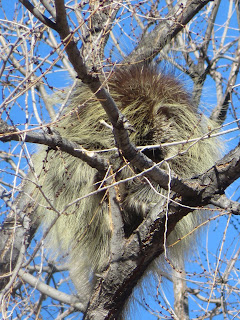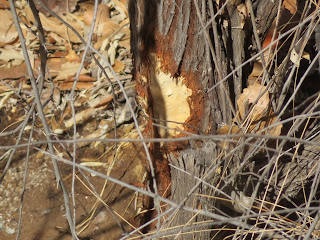Spring frosts seem weird to have in the middle of winter, but most of biology responds to temperature cues, not human timetables. Humans are certainly involved in climate change, but to what extent, and how this will manifest in our lifetime is less clear.
The winds in central New Mexico tends to be very low humidity. We also have a thin atmosphere due to our altitude. These two effects together mean we rarely get moisture coming in from the north. When we do, it doesn't stay long as snow. This beautiful picture of the snowy peaks will disappear quickly.
Here is a picture as the peaks were still actively getting their snow (and trapping 21 restaurant employees on icicle shrouded wires for a day.)
Any time the temperature goes below freezing, we are going to see frost cracks like this in the packed clay. If the surface is uniform, this pattern often looks like a beehive, as a series of hexagons. The process is subtle in Corrales, but can get pretty bizarre in other parts of the world that have periglacial conditions.
Any time the temperature goes below freezing, we are going to see frost cracks like this in the packed clay. If the surface is uniform, this pattern often looks like a beehive, as a series of hexagons. The process is subtle in Corrales, but can get pretty bizarre in other parts of the world that have periglacial conditions.
Roads in Corrales are necessary, if often unwelcome. They place a tough, impermeable surface down that then allows our steel boxes on wheels access to everywhere. However, roads are not the panacea people would think. They have a lot of problems that go along with their great improvements in fast access. Here, the constant temperature changes during the winter causes thermal cracks to form across the width. Especially in tree shaded areas like in this picture.
This crack is longitudinal, and started as an unequal level between two successive layers of hot mix asphalt. Water collected in the seam and eventually froze there. By a process of frost heave the rocks are separated from the binders and removed, leaving behind a hole in the road.
Here is an example of a tunnel under the road forming a crack and subsidence. This was caused by an underground wire being dug under the road, in this instance. This is eventually going to become a major headache for someone (else). For now it is just a small series of potholes.
This big pothole in a unpaved road is quickly formed, but also quickly repaired by simply adding sand or clay to displace the water.
The sandhill cranes seem to prefer feeding right after a hard frost is on the ground. They also retreat to the shade when the sun comes out during the day. They really seem to prefer cold weather and have looked distinctly uncomfortable during some of our warmer winter days this year. This pair are preening together while waiting for the cracked corn to magically appear from out of the neighbor's feeding bins.
This crack is longitudinal, and started as an unequal level between two successive layers of hot mix asphalt. Water collected in the seam and eventually froze there. By a process of frost heave the rocks are separated from the binders and removed, leaving behind a hole in the road.
Here is an example of a tunnel under the road forming a crack and subsidence. This was caused by an underground wire being dug under the road, in this instance. This is eventually going to become a major headache for someone (else). For now it is just a small series of potholes.
This big pothole in a unpaved road is quickly formed, but also quickly repaired by simply adding sand or clay to displace the water.
The sandhill cranes seem to prefer feeding right after a hard frost is on the ground. They also retreat to the shade when the sun comes out during the day. They really seem to prefer cold weather and have looked distinctly uncomfortable during some of our warmer winter days this year. This pair are preening together while waiting for the cracked corn to magically appear from out of the neighbor's feeding bins.
The crows come into roost during the colder days. We seem to have urban and rural crow groups. The urban crows roost and feed around the pedestrian malls and fast food sections of strip malls on the edges of the city. The rural crows feed and socialize at the municipal open dump sites and number many hundreds of individuals. They appear to choose a different location each night, probably to avoid too much attention from the humans below them. I have not yet need much courtship behaviors, but the pairs that nest quickly separate themselves from the unruly mob of (usually juvenile) crows.
White winged doves are common in the bosque. They are often found in the dense stands of russian olive along the edges of the clear ditch. They are foraging for something on the ground, but in a very small area near the foot bridge of La Entrada road.This bird is a Junco (I think) and is hunting small insects on the surface of the water. These birds have already begun chasing larger birds like flickers in territorial displays. This harassment will eventually chase most large birds from the bosque.
Green winged teals hang out with mallards. They are smaller and more nervous, with a wimpy squeak when nervous. We should start seeing more water bird varities as the weather warms up again into April.
Porcupines are currently in a state of torpor as they wait out the cold weather. This one can be reliably found in a single grove of trees each day. Sometimes he is eating the fresh buds of this Siberian elm, but mostly, he snoozes.
Beavers seem to try hard to organize their trees. Each night they select young trees for gnawing. Some are removed, some are just slashed, like this one. Sometime I wonder if they are just marking territory for other beavers to see. This blaze mark is distinctive even for the nearsighted beavers.
Dying trees clearly have their place. A "conk" like this one shows where a fungus is growing inside an old tree. The Corrales bosque is considered very "dense" and the fungus species have no trouble moving from one trunk to another.
Plants are amazing in many ways. This picture shows the deposition of ice crystals on roots. The ice is growing outwards as the cold, but moist air close to the wet ground deposits molecules directly onto the root without forming water. Deposition here means the opposite of sublimation. Plants have the ability to breathe out water vapor through pores in their leaves, which then freezes on the outside of the plant...and protects the plant cells inside from freezing. This is because ice releases heat as it forms, and as long as the ice stays wet, the plant cells inside will not freeze. Plants use many tricks to avoid frost damage. Gardeners have long used this same trick to protect plants from spring freezes.

















I'm amazed how many critters you encounter. When I go to the Bosque, I hard ever see anything but duck and geese.
ReplyDeleteGorgeous photos. Great post. Jim is right. You see things the rest of us miss. So thank you for exposing the magic and beauty all around us.
ReplyDelete